Arctic exploration
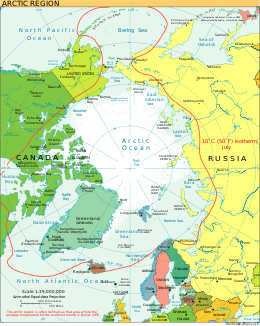
Arctic exploration is the physical exploration of the
Ancient history
Indo-European Hypothesis
A controversial hypothesis, often regarded as pseudohistory, sets the home of the mythical people Hyperboreans in the Arctic. The scientist and author John G. Bennett talked about it in his research paper "The Hyperborean Origin of the Indo-European Culture" (1963).[2] The theory was originally put forth by William F. Warren, the first President of Boston University, in his Paradise Found or the Cradle of the Human Race at the North Pole. Later, Indian independence activist Bal Gangadhar Tilak resurrected Warren's theory in his The Arctic Home in the Vedas (1903), which was dedicated to philologist and indologist Max Müller, with whom Tilak had shared ideas before the book was completed.[3] Austro-Hungarian ethnologist Karl Penka also discussed the same idea in his Origins of the Aryans (1883).[3] Tilak's theory was popularized by Russian nationalists, due to the work of Soviet historian and ethnographer Natalya Romanovna Guseva[4] and Soviet ethnographer S.V Zharnikova,[5] who argued for a northern Urals Arctic homeland of the Indo-Aryan and Slavic people.[6]
Hindu nationalist Madhavrao Sadashivrao Golwalkar also supported and was inspired by Tilak's idea.[7] In his famous 1939 publication We or Our Nationhood Defined, he stated that "Undoubtedly [...] we – Hindus – have been in undisputed and undisturbed possession of this land for over eight or even ten thousand years before the land was invaded by any foreign race."[8]
Ancient Greek historian and geographer
Ancient Greece
Some scholars believe that the first attempts to penetrate the Arctic Circle can be traced to ancient Greece and the sailor
The Middle Ages

Naddodd is said to have encountered Iceland when he lost his route due to harsh conditions when sailing from Norway to the Faroe Islands in the 860's.[11] In the 10th century, Gunnbjörn Ulfsson got lost in a storm and ended up within sight of the Greenland coast. His report spurred Erik the Red, an outlawed chieftain, to establish a settlement there in 985. While they flourished initially, these settlements eventually petered out until about 1450. Initially this abandonment of the colony was credited to the Little Ice Age but that has been disputed by recent studies which suggest there were more complex factors at play.[12]
Greenland's early settlers sailed westward, in search of better pasturage and hunting grounds. Modern scholars debate the precise location of the new lands of Vinland, Markland, and Helluland that they discovered.[13]
The
Russian
Age of Discovery
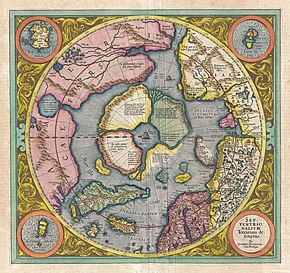
Exploration to the north of the Arctic Circle in the
Renaissance advancements in cartography

A seminal event in Arctic exploration occurred in 1409, when
Northwest Passage
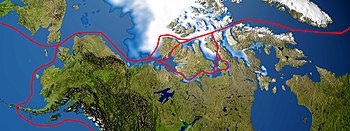
The
Interest re-kindled in 1564 after
In 1585, under the employ of
Though England's efforts were interrupted in 1587 because of the Anglo-Spanish War, Davis's favorable reports on the region and its people would inspire explorers in the coming century.[19] In 1609, while in the service of the Dutch East India Company, the English explorer Henry Hudson sailed up what is now called the Hudson River in search of the Passage; he reached present-day Albany, New York, before giving up. He later explored further north into the Arctic and Hudson Bay for the Passage.[20][21]
The Northeast Passage
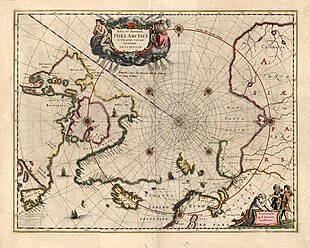
The Northeast Passage is a broad term for any route lying above the Eurasian continent and stretching between the waters north of the Norwegian Sea to the Bering Strait. The "Northern Sea Route" is defined as a specific portion of such routes. The Northern Sea Route (capitalized) as currently officially defined by Russian Federation law includes
The idea to explore this region was initially economic, and was first put forward by Russian diplomat Dmitry Gerasimov in 1525. The entire route laid in Arctic waters and parts and was usually covered in ice, making it a very perilous journey.[22]
In the mid-16th century, John Cabot's son

Western parts of the passage were simultaneously being explored by Northern European countries like England, the Netherlands, Denmark and Norway, looking for an alternative seaway to China and India. Most notable is the 1596 expedition led by Dutch navigator
Fearing English and Dutch penetration into Siberia, Russia closed the Mangazeya seaway in 1619. Pomor activity in Northern Asia declined and the bulk of exploration in the 17th century was carried out by Siberian Cossacks, sailing from one river mouth to another in their Arctic-worthy kochs. In 1648 the most famous of these expeditions, led by Fedot Alekseev and Semyon Dezhnev, sailed east from the mouth of Kolyma to the Pacific and doubled the Chukchi Peninsula, thus proving that there was no land connection between Asia and North America.[24] Eighty years after Dezhnev, in 1728, another Russian explorer, Danish-born Vitus Bering on Sviatoy Gavriil made a similar voyage in reverse, starting in Kamchatka and going north to the passage that now bears his name (Bering Strait). It was Bering who gave their current names to Diomede Islands, discovered and first described by Dezhnev.[25]
It was not until in 1878 that Finnish-Swedish explorer
Northwest Passage

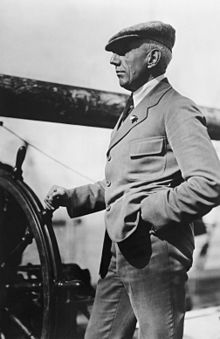
In the first half of the 19th century, parts of the Northwest Passage were explored separately by a number of different expeditions, including those by
The Northwest Passage was not completely conquered by sea until 1906, when the Norwegian explorer Roald Amundsen, who had sailed just in time to escape creditors seeking to stop the expedition, completed a three-year voyage in the converted 47-ton herring boat Gjøa. At the end of this trip, he walked into the city of Eagle, Alaska, and sent a telegram announcing his success. His route was not commercially practical; in addition to the time taken, some of the waterways were extremely shallow.[29]
Knud Rasmussen (1879–1933) led several Arctic expeditions. He grew up in Greenland speaking Greenlandic and Danish, and has been called the "father of Eskimology"[30] and was the first Greenlander of Inuit and European descent to cross the Northwest Passage via dog sled.[31] Rasmussen and his friend Peter Freuchen participated in seven Thule Expeditions, named after ultima Thule, and wrote numerous books on their Arctic experiences.
The North Pole

On April 6, 1909, Robert Peary claimed to be the first person in recorded history to reach the North Pole[26] (although whether he actually reached the Pole is disputed).[1][32] He traveled with the aid of dogsleds and three separate support crews who turned back at successive intervals before reaching the Pole. Many modern explorers, including Olympic skiers using modern equipment, contend that Peary could not have reached the pole on foot in the time he claimed.
A number of previous expeditions set out with the intention of reaching the North Pole but did not succeed; that of British naval officer
On May 9, 1926, Americans
The crew of the airship Norge (including Roald Amundsen and the American sponsor Lincoln Ellsworth) flew over the Pole on May 12, 1926. This is the first undisputed sighting of the Pole. Norge was designed and piloted by the Italian Umberto Nobile, who overflew the Pole a second time on May 24, 1928. Nobile's second trip was in the airship Italia that ran into a storm on the return trip and crashed on the ice. Survivors were eventually recovered. Amundsen disappeared, with the crew of his sea plane, during the rescue operations.
The first people to have without doubt walked on the North Pole were the Soviet party of 1948 under the command of Alexander Kuznetsov, who landed their aircraft nearby and walked to the pole.[35]
On August 3, 1958, the American submarine USS Nautilus (SSN-571) reached the North Pole without surfacing. It then proceeded to travel under the entire Polar ice cap. On March 17, 1959, the USS Skate (SSN-578) surfaced on the North Pole and dispersed the ashes of explorer Sir Hubert Wilkins. These journeys were part of military explorations stimulated by the Cold War context.
On April 19, 1968, Ralph Plaisted reached the North Pole via snowmobile, the first surface traveler known with certainty to have done so. His position was verified independently by a US Air Force meteorological overflight. In 1969 Wally Herbert, on foot and by dog sled, became the first man to reach the North Pole on muscle power alone, on the 60th anniversary of Robert Peary's famous but disputed expedition.
The first persons to reach the North Pole on foot (or skis) and return with no outside help, no dogs, airplanes, or re-supplies were Richard Weber (Canada) and Misha Malakhov (Russia) in 1995. No one has completed this journey since.
U.S. Air Force Lieutenant Colonel Joseph O. Fletcher and Lieutenant William Pershing Benedict landed a plane at the Pole on May 3, 1952, accompanied by the scientist Albert P. Crary.[36]
On 2 May 2007, BBC's Top Gear reached the 1996 position of the magnetic north pole (78°35.7′N 104°11.9′W / 78.5950°N 104.1983°W) in a modified Toyota Hilux.
On 2 August 2007, during Arktika 2007 Russian crewed submersibles were the first to descend to the seabed below the pole.
On April 26, 2009,
See also
- Farthest North
- List of polar explorers
- List of Arctic expeditions
- List of Arctic exploration vessels
- List of firsts in the Geographic North Pole
- Great Northern Expedition
- List of Antarctic expeditions
- Heroic Age of Antarctic Exploration
- History of Antarctica
- History of research ships
- List of Russian explorers
- Timeline of European exploration
- Drifting ice station
- Deep-sea exploration
- Space exploration
- Nikolai Pinegin
Notes
- ^ a b c d "Arctic, The". Columbia Encyclopedia, Sixth Edition. Columbia University Press. 2004. Archived from the original on 4 January 2013. Retrieved 19 October 2006.
- ^ Bennett, John G (December 1963). "The Hyperborean Origin of the Indo-European Culture". Systematics. 1 (3). Archived from the original on 14 September 2011.
- ^ ISBN 0500277133.
- ^ Shnirelman (2007), pp. 38–39.
- ^ Shnirelman (2007), p. 40.
- ^ Shnirelman (2007), pp. 38–41.
- ^ Schaeffer, Carol (2018). "Alt-Reich. The unholy alliance between India and the new global wave of white supremacy". The Caravan: 42.
- ^ Pandey, Gyanendra (2006). Routine Violence: Nations, Fragments, Histories. Stanford University Press. p. 103.
- ISBN 0300052669
- ISBN 978-1316850701.
- ^ Hoare, J. Douglas (1906). Arctic Exploration. Retrieved 31 December 2021.
Occasionally one of them would happen on a new country by accident, just as Naddod the Viking happened upon Iceland in 861 by being driven there by a gale while on his way to the Faroe Islands.
- ^ Mooney, Chris (4 December 2015). "Vikings' mysterious abandonment of Greenland was not due to climate change, study suggests". The Washington Post. Retrieved 31 December 2021.
- . Retrieved 31 December 2021.
- S2CID 133255837. Retrieved 1 January 2022.
- ^ "Ptolemy's Geography". www.ibiblio.org.
- ^ Oleson, T.J. (1979) [1966]. "Zeno, Nicolò". In Brown, George Williams (ed.). Dictionary of Canadian Biography. Vol. I (1000–1700) (online ed.). University of Toronto Press.
- ^ Davis, John (1880). The Voyages and Works of John Davis, the Navigator. Hakluyt Society. p. 20. Retrieved 1 January 2022.
- JSTOR 24246301. Retrieved 1 January 2022.
- ^ Abacuk Pricket (1625). "Excerpt from A Larger Discourse of the Same Voyage". Chass.utoronto.ca. Archived from the original on 24 August 2007. Retrieved 19 February 2011.
- ^ Neatby, L. H. (1979) [1966]. "Hudson, Henry". In Brown, George Williams (ed.). Dictionary of Canadian Biography. Vol. I (1000–1700) (online ed.). University of Toronto Press.
- S2CID 143663630. Retrieved 1 January 2022.
- ^ Wright, Helen Saunders (1910). The great white North: the story of polar exploration from the earliest times to the discovery of the Pole. The Macmillan co. pp. 7.
helen wright great white north.
- ^ Fisher, Raymond H (1981). The Voyage of Semen Dezhnev in 1648. The Hakluyt Society.
- ISBN 8772889322.
- ^ a b "Arctic Exploration – Chronology". Quark Expeditions. 2004. Archived from the original on 11 September 2006. Retrieved 19 October 2006.
- ^ Berton (1988), p. 219.
- ^ Richards, R. L. (1990). "John Rae". In Halpenny, Francess G (ed.). Dictionary of Canadian Biography. Vol. XII (1891–1900) (online ed.). University of Toronto Press. Retrieved 20 October 2006.
- ^ "Northwest Passage". The Canadian Encyclopedia. Historica Canada. 2006. Archived from the original on 2 January 2007. Retrieved 20 October 2006.
- ^ Jean Malaurie, 1982.
- ^ Alley, Sam. "Knud Johan Victor Rasmussen". Mankato: Minnesota State University. Archived from the original on 12 October 2010. Retrieved 23 November 2015.
- ^ Wallace, Hugh N. (22 March 2015). "North Pole". The Canadian Encyclopedia. Historica Canada. Archived from the original on 30 September 2007. Retrieved 20 October 2006.
- ^ See references on Frederick Cook for more information.
- ISBN 978-0060819057.
- ^ Concise chronology of approach to the poles, Scott Polar Research Institute. retrieved 2010-06-04.
- OCLC 486837.
Bibliography
- ISBN 0385658451.
- Edinger, Ray (2015). Love and Ice: The Tragic Obsessions of Dr. Elisha Kent Kane, Arctic Explorer. Frederic C. Beil, Publisher. OCLC 660553369
- McCannon, John (2012). A History of the Arctic: Nature, Exploration and Exploitation. Reaktion Books and University of Chicago Press. ISBN 978-1780230184
- McCannon, John (1998). Red Arctic: Polar Exploration and the Myth of the North in the Soviet Union. Oxford University Press. ISBN 978-0195114362
- ISBN 0226721841
- Sale, Richard (2002). To the ends of the earth: the history of Polar exploration. London: HarperCollins. OCLC 48836382.
- Shnirelman, Victor (2007). "Archaeology, Russian Nationalism, and the "Arctic Homeland"". In Philip L Kohl; Mara Kozelsky; Nachman Ben-Yehuda (eds.). Selective Remembrances: Archaeology in the Construction, Commemoration, and Consecration of National Pasts. University of Chicago Press. Also: Selective Remembrances at Google Books
- Simmons, George (1965). Target: Arctic; Men in the Skies at the Top of the World. Chilton Books. OCLC 486837.
External links
 Media related to Exploration of the Arctic at Wikimedia Commons
Media related to Exploration of the Arctic at Wikimedia Commons- To the North Pole Archived 2011-12-21 at the Life magazine
- Freeze Frame – collection of historic polar images at the Scott Polar Research Institute, University of Cambridge. Represents the history of British exploration and science in the Arctic and Antarctic during the period 1845–1960. Also covers early European and international collaborative ventures in the polar regions, portraiture, shipping and aerial reconnaissance.
- "Why Go To The Arctic?", January 1931, Popular Mechanics
- Albert Operti Correspondence with Arctic Explorers at Dartmouth College Library
- William Hunt Manuscript and Correspondence on Arctic Explorers at Dartmouth College Library
